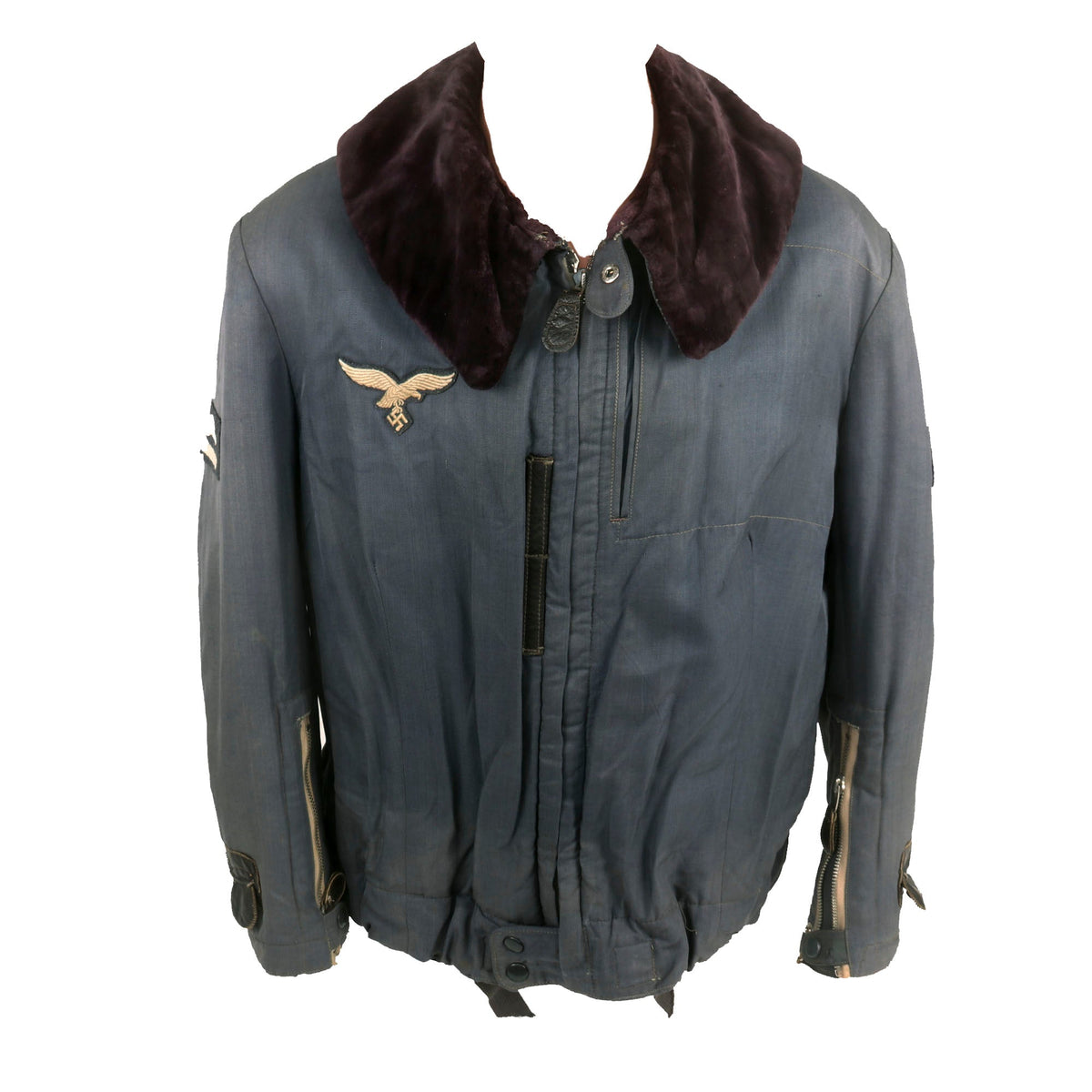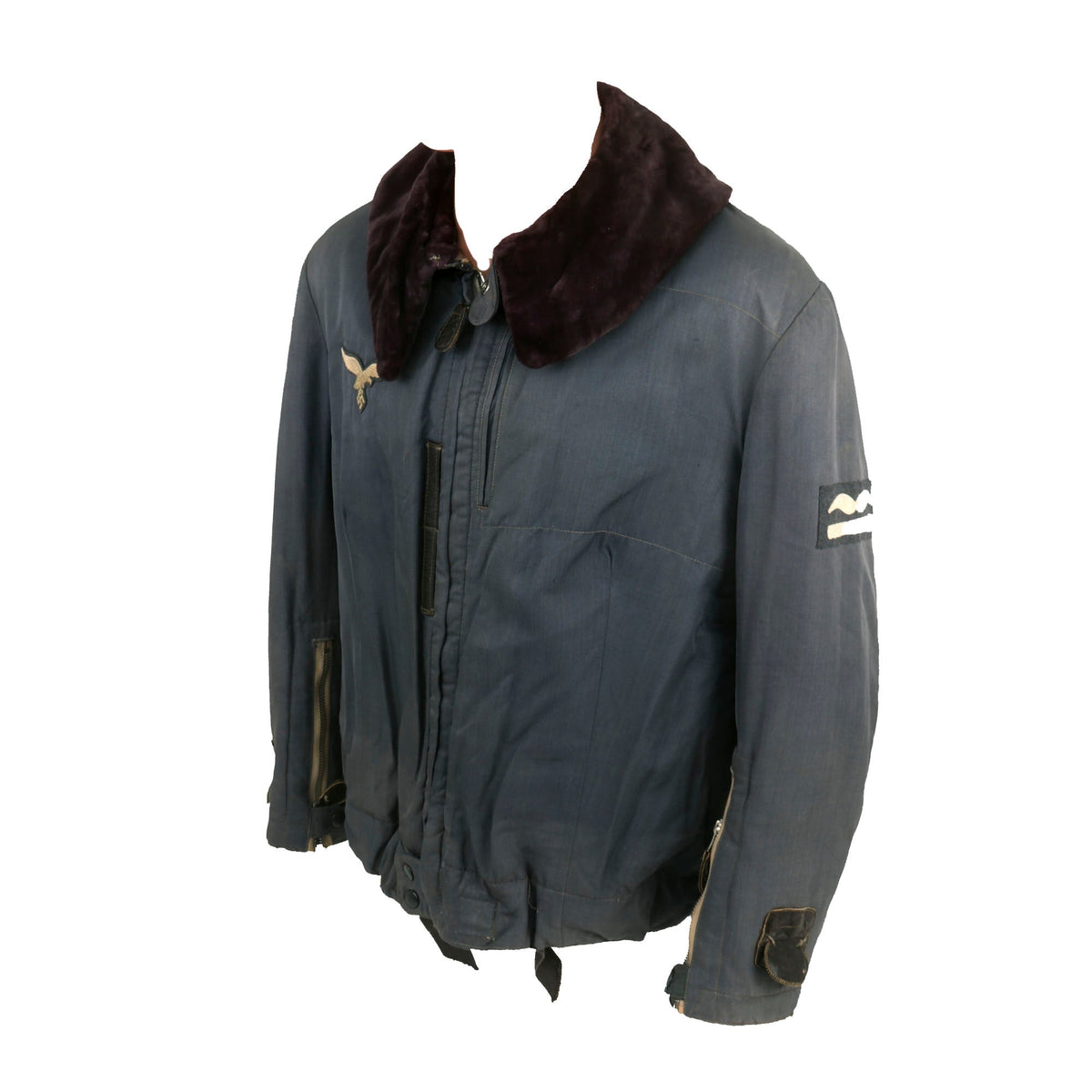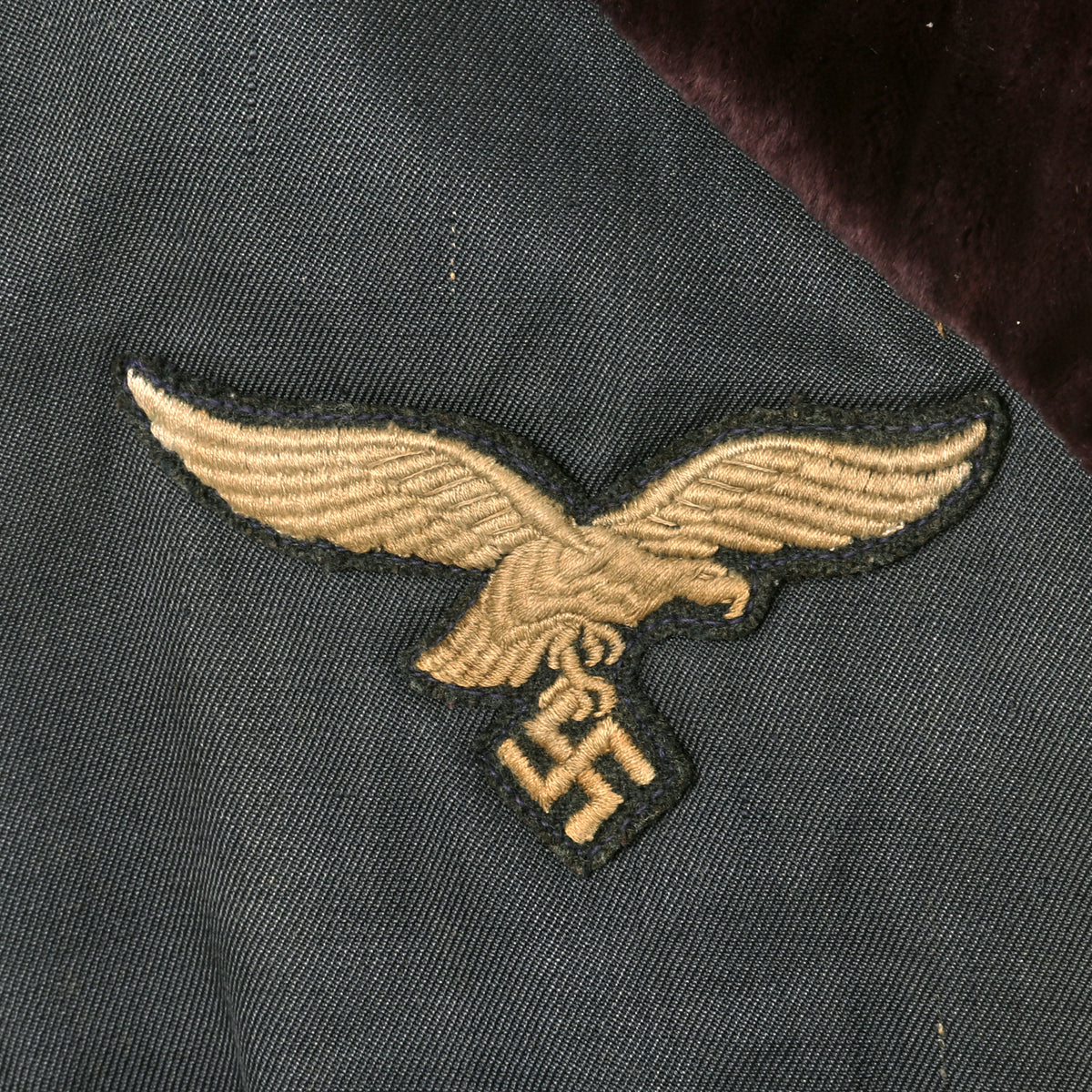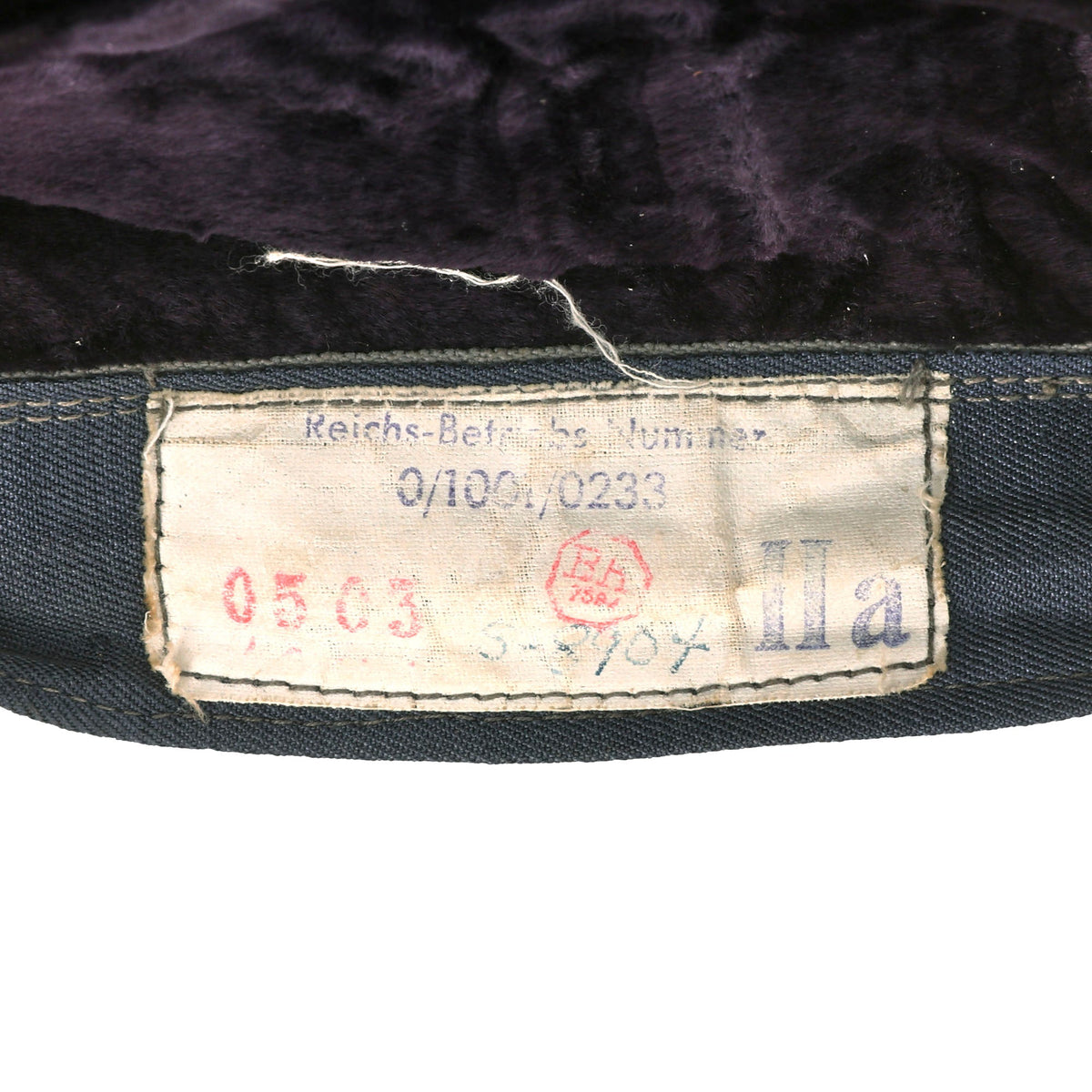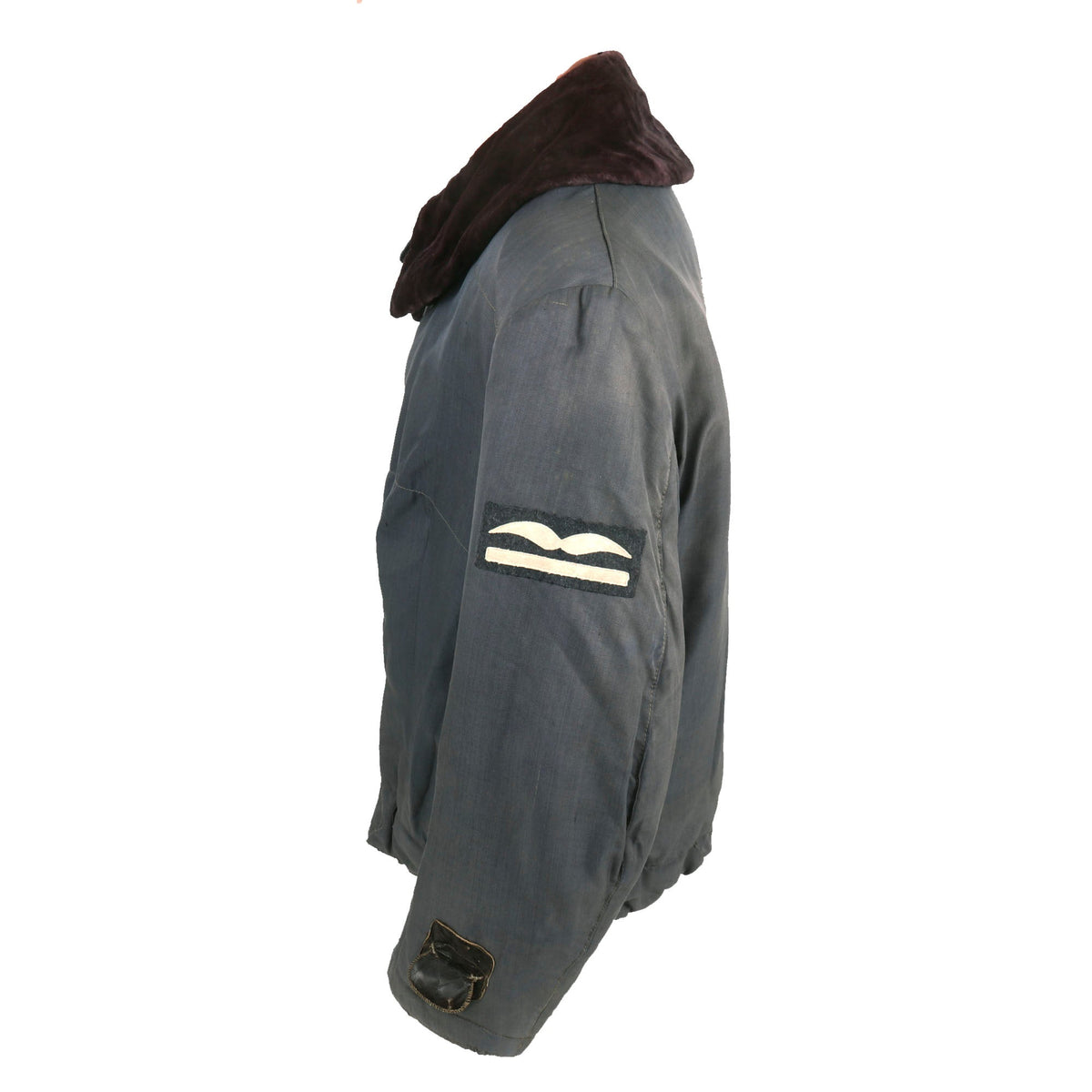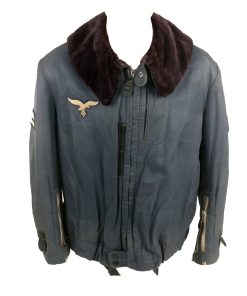Original German WWII Luftwaffe Blue Electric Heated Leutnant Officer’s Winter Flying Jacket – RBNr. Marked Original Items
$ 2.895,00 $ 723,75
Original Item: Only One Available. Development of protective flight uniforms and equipment began with the advent of military aircraft in WWI and continued on into the Weimar and the Third Reich eras, resulting in three distinct one-piece combination pattern flight suits being approved before WWII and worn for the duration of the war with minor modifications. There were also two piece varieties developed at the same time, which allowed more flexibility in fit and use.
This is an excellent condition heavy winter flight jacket, constructed from a blue twill fabric shell, with a purple velvet plush type material collar and lining. This extends into the sleeves as well, and really looks great. It features a plug in wired heating system, which still looks to be intact, having a wire on the interior that would probably connect to the pants portion of the set. There are also additional connectors at the ends of the sleeves for the use of heated gloves.
The jacket features a lovely embroidered Luftwaffe eagle on the right chest, and the sleeves both bear rank insignia showing a single white bar at the bottom, with a single “gull wing” above, indicating the junior officer rank of Leutnant (2nd Lieutenant). We checked the snaps and all are STOCKO marked, a known supplier of snaps for the Luftwaffe during WWII. The main closure zipper is by PRYM, while the sleeve zippers are by ZIPP, and all still have their original leather pull tabs. Everything looks totally correct, and this is really a great example. All of the zippers are complete and functional, and there are no missing pieces we can see.
There is still an original maker label on the underside of the flap that goes over the main closure, which also bears some inspection stamps. It reads:
Reichs-Betriebs Nummer
0/1001/0233
0503 2-8904 IIa
We assume that the “IIa” refers to the size of the jacket, and there does not appear to be any other type of size indication. Research might possibly be able to identify the maker, however the RBNr. system remains mostly unknown, even today.
A lovely example of a Luftwaffe Heated Winter Flying jacket, outfitted with Leutnant Officer’s sleeve insignia and ready to display!
Approximate Measurements:
Collar to shoulder: 11″
Shoulder to sleeve: 23.5”
Shoulder to shoulder: 18”
Chest width: 22″
Waist width: 21″
Front length: 26.5″
Reichsbetriebsnummer or RB number (also represented as RB Nr or Rbnr). Before the war, the Germans set up a system for registering and recording the factory information, the Reichsbetriebskartei. This was to help enable machine tabulation of facts and figures. It was from this that the Reichsbetriebsnummer came into being. The Reichsministerium für Rüstung und Kriegsproduktion (Ministry for Armaments and War Production) files survive today in the Bundesarchiv, however, these are only fragmentary. There is a holding file from the working group created by the Office of Machine Reporting in the Armament Office of the Reich Ministry for Armaments and War Production – their main focus was the operations of the industry group for which an economic interest was Armour production. This index provides information on the most important data of the companies covered by it, production profile, operating area, number of employees and the responsible operator.
As a prerequisite for the intended use of the punch-card method in the armaments industry, it was this system which gave rise to the Rbnr. The operating numbers were assigned by the competent local district offices of Machine reporting. (Bezirksstellen des Maschinellen Berichtswesens.) The index is in the form of index cards that are accessible numerically (approximately 14 meters of index cards!). Access to this register is only possible through the naming of this company, stating the place of production. The Reichsministerium für Rüstung und Kriegsproduktion files have multiple entries on the introduction of the factory and also the lot no.
The Rbnr code was used from 1943 onwards and replaced the makers name and address (or company logo) on government contract uniforms, caps and field equipment and knives. It is either rubber ink stamped on cloth or die stamped onto leather & metal items. It has been written countless times that this numeric code system was introduced as a security measure to help mask production locations. This was not the case but it was perhaps, a helpful by- product of the system. It is not unknown to find the Rbnr together with the maker’s info. Had it been a security measure, clearly this practise would have been banned.
So what was the Rbnr? It was a nine digit number and was normally represented thus: RB Nr: 0/000/0000.
The first prefix number could range from 0 through to 9. This number determined the membership of the various groups in the realm of Trade and Industry (Reichsgruppenleitzahl)
• 0 Industry
• 1 Crafts
• 2 Commercial wholesale trading companies
• 3 Banking
• 4 Insurance Companies
• 5 Energy (Electrical companies and such)
• 6 Tourism (Including Hotels, Wine and Mineral Water companies)
• 7 Traffic
• 8 Food Industry
• 9 Not otherwise mentioned groups
Fast Shipping with Professional Packaging
Thanks to our longstanding association with UPS FedEx DHL, and other major international carriers, we are able to provide a range of shipping options. Our warehouse staff is expertly trained and will wrap your products according to our exact and precise specifications. Prior to shipping, your goods will be thoroughly examined and securely secured. We ship to thousands clients each day across multiple countries. This shows how we're dedicated to be the largest retailer on the internet. Warehouses and distribution centres can be located throughout Europe as well as the USA.
Note: Orders with more than one item will be assigned a processing date depending on the item.
Before shipping before shipping, we'll conduct a thorough inspection of the items you have ordered. Today, the majority of orders will be delivered within 48 hours. The delivery time will be between 3-7 days.
Returns
The stock is dynamic and we cannot completely manage it because multiple stakeholders are involved, including our factory and warehouse. So the actual stock may alter at any time. It's possible that you may not receive your order once the order has been made.
Our policy is valid for a period of 30 days. If you don't receive the product within 30 days, we are not able to issue a refund or an exchange.
You can only return an item if it is unused and in the same state as the day you received it. You must have the item in its original packaging.
Related products
Uncategorized
Uncategorized
Uncategorized
Uncategorized
Uncategorized
Uncategorized
Uncategorized
Uncategorized
Uncategorized
Uncategorized
Uncategorized
Angolan Rebel 1970s era 60mm Inert Display Mortar from Angolan Civil War Original Items
Uncategorized
Band of Brothers ORIGINAL GERMAN WWII Le. F.H. 18 10.5cm ARTILLERY PIECE Original Items
Uncategorized
Uncategorized
Australian WWII Owen MK1 Machine Carbine SMG Custom Fabricated Replica with Sling Original Items
Uncategorized
Uncategorized
Uncategorized
Uncategorized
Uncategorized
